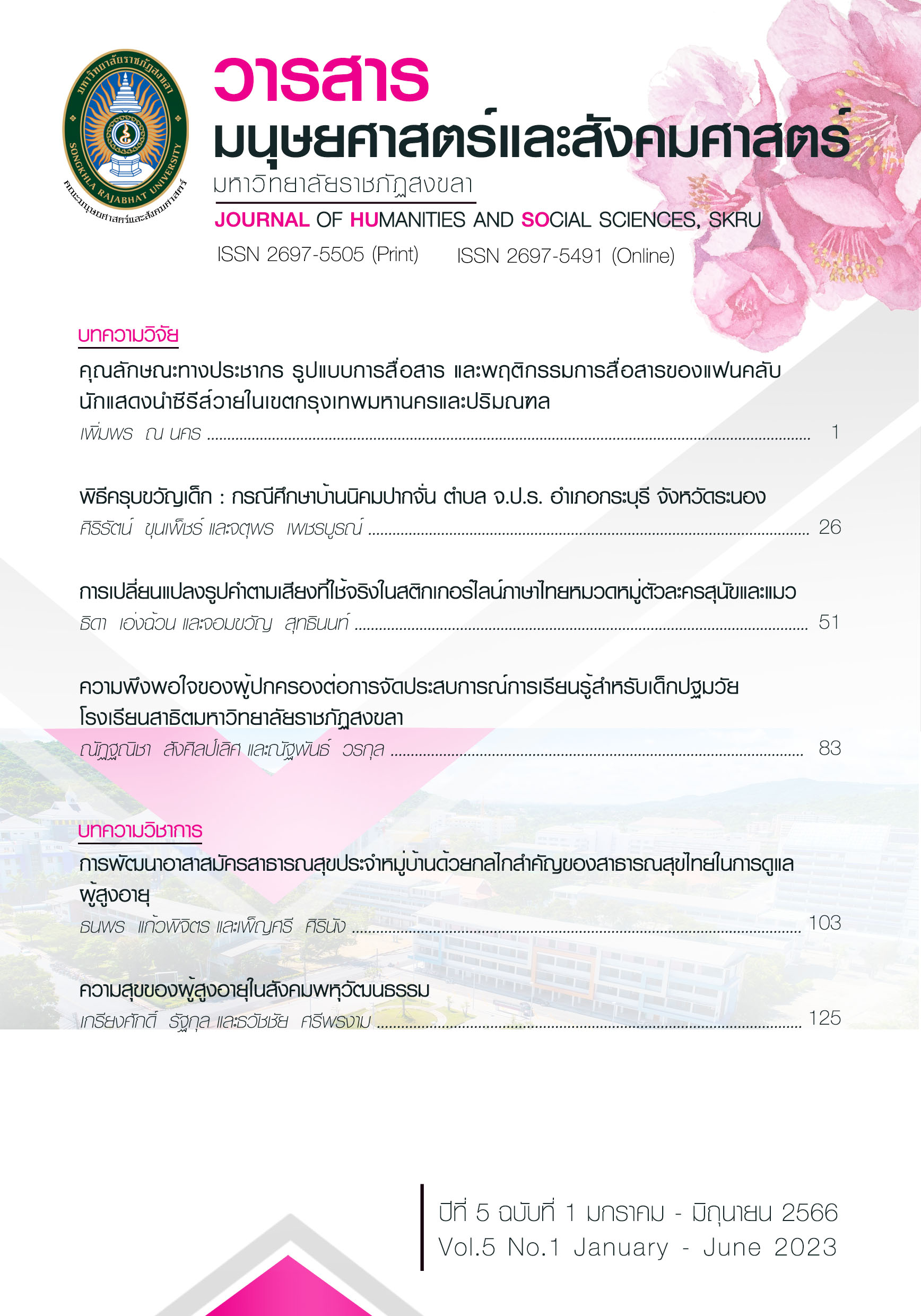CHANGES OF WORD FORM WRITTEN ACCORDING TO SPOKEN SOUNDS ON THAI LINE STICKERS IN THE CATEGORIES OF DOG AND CAT CHARACTERS
Main Article Content
Abstract
The objective of this study was to analyze changes of words form that are written according to spoken sounds on Thai LINE stickers in the categories of dog and cat characters. Data were retrospectively collected from December 2, 2022, from 20 sets of Thai LINE stickers in the Creator’s stickers of LINE Store. A total of 792 stickers were collected and 107 stickers with words written according to spoken sounds were selected for analysis based on the concepts of changes in current Thai usage and changes in the sound of word units. The study found 1) changes in word form written according to the sounds of the current spoken Thai on 97 stickers (90.65 percent). The changes could be classified into 6 types: the changes of the initial consonants, ending consonants, vowels, forms of consonants and vowels, forms of tones, and the forms of consonants, vowels, and tones. The most frequently found type was the change from short to long vowels on 11 stickers (35.48 percent), and the least frequently found was the change to approximant final consonant on 1 sticker (25.00 percent), and 2) changes of sounds in word units which were found on 10 stickers (9.35 percent) and could be classified into 3 types: assimilation, sound loss, and consonant addition. Because LINE is used for informal communication, changes in sounds on the Thai stickers reflect that language is always changing.
Downloads
Article Details

This work is licensed under a Creative Commons Attribution-NonCommercial-NoDerivatives 4.0 International License.
ลิขสิทธิ
References
กุหลาบ มัลลิกะมาศ. (2547). ภาษาไทยของเรา. กรุงเทพฯ: สมาคมภาษาและหนังสือแห่งประเทศไทยในพระบรมราชูปถัมภ์.
จอมขวัญ สุทธินนท์. (2563). การเปลี่ยนแปลงของเสียงที่สะกดตามเสียงพูดที่ส่งผลกระทบต่อการใช้ภาษาไทยด้านเสียงปัจจุบันในสติกเกอร์ไลน์ภาษาไทย. วารสารวิชาการ มหาวิทยาลัยราชภัฏบุรีรัมย์. 12(1), 51-69.
จอมขวัญ สุทธินนท์. (2564). การเปลี่ยนแปลงของเสียงที่สะกดตามเสียงพูดแบบมีเงื่อนไขร่วมกับการเปลี่ยนแปลงของเสียงที่สะกดตามเสียงพูดที่ส่งผลกระทบต่อการใช้ภาษาไทยด้านเสียงปัจจุบันในสติกเกอร์ไลน์ภาษาไทย. วารสารมหาวิทยาลัยมหามกุฏราชวิทยาลัย วิทยาเขตร้อยเอ็ด. 10(2), 91-105. https://so01.tcithaijo.org/index.php/AJMBU/article/view/239924/167284
ซารีณา นอรอเอ, นุรอัซวีตา จารง, ณฐพร มุสิกเจริญ และวรเวทย์พิสิษ ยศสิริ. (2561). ลักษณะการใช้ภาษาบนสื่อสังคมออนไลน์ของวัยรุ่นไทยในปัจจุบัน. พลวัตการศึกษายุคเศรษฐกิจและสังคมดิจิทัล. การประชุมหาดใหญ่วิชาการระดับชาติและนานาชาติ ครั้งที่ 9. (940-952). https://wb.yru.ac.th/bitstream/yru/6190/1/2561-HNICSarina940-952.pdf
ฐิติภา คูประเสริฐ. (2551). การศึกษาภาษาที่ใช้ในไดอารี่ออนไลน์: เดือนตุลาคม 2549-เดือนมีนาคม 2550 [วิทยานิพนธ์ปริญญามหาบัณฑิต, มหาวิทยาลัยธรรมศาสตร์].
ธิดา เอ่งฉ้วน และจอมขวัญ สุทธินนท์. (2565). คำสแลงที่ปรากฏในสติกเกอร์ไลน์สุดฮิตหมวดหมู่ตัวละครสุนัขและแมว. การประชุมนำเสนอผลงานวิจัยบัณฑิตศึกษาระดับชาติ มหาวิทยาลัยราชภัฏอุดรธานี ครั้งที่ 15. (932-943). มหาวิทยาลัยราชภัฏอุดรธานี.
นิตยา กาญจนะวรรณ. (16, สิงหาคม, 2545). การใช้ภาษาต่างประเทศในภาษาไทย. เอกสารประกอบในการสัมมนาทางวิชาการ จัดโดยราชบัณฑิตยสถาน เรื่องภาษไทยปัจจุบัน: ปัญหาและแนวทางแก้ไข.
ปองจิต อ่อนเผ่า. (2552). ข้อคิดจากการเปลี่ยนแปลงการใช้ภาษาไทยปัจจุบัน. วารสารวรรณวิทัศน์. 9, 121-133.
พระมหานรินทร์ ประสมพงศ์. (2563). วัยรุ่นยุคใหม่กับการใช้ภาษาไทยที่ควรรู้. วารสารศึกษาศาสตร์ มมร คณะศึกษาศาสตร์ มหาวิทยาลัยมหามกุฏราชวิทยาลัย. 8(2), 182-194. http://ojs.mbu.ac.th/index.php/edj/article/view/1134/848
พิมพ์ประไพ บุญสม. (2556). อุปลักษณ์ในสำนวนภาษาอังกฤษเกี่ยวกับสัตว์ [วิทยานิพนธ์ปริญญามหาบัณฑิต, มหาวิทยาลัยศิลปากร].
ภาวาส บุนนาค. (2547). ภาษาไทยของเรา. กรุงเทพฯ: สมาคมภาษาและหนังสือแห่งประเทศไทยในพระบรมราชูปถัมภ์.
วรวรรธน์ ศรียาภัย. (2556). ภาษาศาสตร์ภาษาไทย. (พิมพ์ครั้งที่ 2). นนทบุรี: สัมปชัญญะ.
วิไลวรรณ ขนิษฐานันท์. (2526). ภาษาศาสตร์เชิงประวัติ : วิวัฒนาการภาษาไทยและภาษาอังกฤษ. กรุงเทพฯ: มหาวิทยาลัยธรรมศาสตร์.
LINE STORE. (2565ก). เหมียวขอ. สืบค้นเมื่อ 2 ธันวาคม 2565, จาก https://store.line.me/stickershop/product/12312952/th
LINE STORE. (2565ข). แก๊งปุยปุย. สืบค้นเมื่อ 2 ธันวาคม 2565, จาก https://store.line.me/stickershop/product/13734576/th
LINE STORE. (2565ค). แชทโซเชียลกับน้องเหมียว. สืบค้นเมื่อ 2 ธันวาคม 2565, จาก https://store.line.me/stickershop/product/19952695/th
LINE STORE. (2565ง). แมวและคำพูดสนุกสนาน. สืบค้นเมื่อ 2 ธันวาคม 2565, จาก https://store.line.me/stickershop/product/18810118/th
LINE STORE. (2565จ). ไว้แชทขำๆกวนๆ. สืบค้นเมื่อ 2 ธันวาคม 2565, จาก https://store.line.me/stickershop/product/19946891/th
LINE STORE. (2565ฉ). คุโมะ หมาหยุกหยิก. สืบค้นเมื่อ 2 ธันวาคม 2565, จาก https://store.line.me/stickershop/product/19504571/th
LINE STORE. (2565ช). ฉันรักงานนี้แมวกวนพาสเทล. สืบค้นเมื่อ 2 ธันวาคม 2565, จาก https://store.line.me/stickershop/product/20029387/th
LINE STORE. (2565ซ). ช็อคโกแลต หมาซ่า. สืบค้นเมื่อ 2 ธันวาคม 2565, จาก https://store.line.me/stickershop/product/19994008/th
LINE STORE. (2565ฌ). ชิโระ ต้าวหมาตุ้ยนุ้ย. สืบค้นเมื่อ 2 ธันวาคม 2565, จาก https://store.line.me/stickershop/product/19291786/th
LINE STORE. (2565ญ). ซูโม่แคทแมวจอมกวน 2. สืบค้นเมื่อ 2 ธันวาคม 2565, จาก https://store.line.me/stickershop/product/19880972/th
LINE STORE. (2565ฎ). ลูกหมาของแม่นาก. สืบค้นเมื่อ 2 ธันวาคม 2565, จาก https://store.line.me/stickershop/product/60004/th
LINE STORE. (2565ฏ). วิเชียรมึนแฮปปี้ฝุดๆ. สืบค้นเมื่อ 2 ธันวาคม 2565, จาก https://store.line.me/stickershop/product/199 94207/th
LINE STORE. (2565ฐ). อ้วนกลม หมาน้อยแสนซน. สืบค้นเมื่อ 2 ธันวาคม 2565,จาก https://store.line.me/stickershop/product/11832683/th


